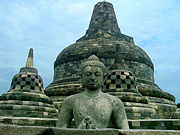Stupa

A stupa (from Sanskrit and Pāli: m., स्तूप, stūpa, literally meaning "heap") is a mound-like structure containing Buddhist relics, once thought to be places of Buddhist worship, typically the remains of a Buddha or saint. In other Asian languages such monuments are called
After "stupa," chorten (from the Tibetan chos rtan) is the most commonly-encountered English term. The term "reliquary" is sometimes used, after a Roman Catholic functional equivalent.
Stupas are an ancient form of mandala.[1]
Contents |
Description and history




The stupa is the latest Buddhist religious monument and was originally only a simple mound of mud or clay to cover supposed relics of the Buddha. After the parinirvana of the Buddha, his remains were cremated and the ashes divided and buried under eight stupas with two further stupas encasing the urn and the embers. Little is known about these early stupas, particularly since it has not been possible to identify the original ten monuments. However, some later stupas, such as at Sarnath and Sanchi, seem to be embellishments of earlier mounds.
In the third century BCE, after his conversion to Buddhism, the emperor Ashoka had the original stupas opened and the remains distributed among the several thousand stupas he had built. Nevertheless, the stupas at the eight places associated with the life of the Buddha continued to be of particular importance. Accordingly, the importance of a stupa changed from being a funerary monument to being an object of veneration. As a consequence their appearance changed also. Stupas were built in Sri Lanka soon after King Devanampiyatissa converted to Buddhism, the first stupa to be built was the Thuparamaya. Later on Sri Lanka went on to build many stupas over the years, some like the Jetavanarama in Anuradhapura being one of the tallest ancient structures in the world.
They evolved into large hemispherical mounds with features such as the torana (gateway), the vedica (fence-like enclosure evolved from the vedic villages), the harmika (a square platform with railings on top of the stupa), chattrayashti (the parasol or canopy) and a circumambulatory around the stupa. From the first century BCE onwards, stupas were incorporated into the hall of the chaitya-griha.
One such stupa was discovered at Sopara, an ancient port near Mumbai, and is believed to be one of most ancient stupas in the world. The oldest known stupa is the Dhamek Stupa at Sarnath, India, while the tallest is the Phra Pathom Chedi in Nakhon Pathom, Thailand, at a height of 127 metres. The most elaborate stupa is the 8th century Borobudur monument in Java, Indonesia. The upper rounded terrace with rows of bell shaped stupas contained buddha images symbolizing Arupadhatu, the sphere of formlessness. The main stupa itself is empty, symbolizing complete perfection of enlightenment. The main stupa is only the crown part of the monument, while the base is pyramidal structure elaborate with galleries adorned with bas relief of scenes derived from Buddhist text depicted the life of Siddharta Gautama. Borobudur unique and significant architecture has been acknowledge by UNESCO as the largest buddhist monument in the world.
The stupa evolved into the pagoda as Buddhism spread to other Asian countries. The pagoda has varied forms that also include bellshaped and pyramidal ones. Today, in the Western context, there is no clear distinction between the stupa and the pagoda. But in general stupa is used for a Buddhist structure of India or south-east Asia, while pagoda refers to a building in east Asia which can be entered and which may be secular in purpose.
Fundamentally, a stupa is essentially made up of the following five constituent parts:
- a square base
- a hemispherical dome
- a conical spire
- a crescent moon
- a circular disc
Each component is rich in metaphoric content. For example, "the shape of the stupa represents the Buddha, crowned and sitting in meditation posture on a lion throne. His crown is the top of the spire; his head is the square at the spire's base; his body is the vase shape; his legs are the four steps of the lower terrace; and the base is his throne." [2] The components of the stupa are also identified with the five elements — earth, water, fire, air, and space — held to constitute the fabric of manifest existence.
Regional names for stupa include:
- Chaitya - Nepal
- Candi - Indonesia and Malaysia
- Chedi - Thailand (เจดีย์)
- Chorten - Tibet and Bhutan
- Dagoba/Chaitiya - Sri Lanka
- Chedey - Cambodia
- Sübürgen - Mongolia
- Tap - Korea (塔/탑 lit: "tower")
- Tháp - Vietnam (塔 lit: "tower")
- Thart - Laos
- Ta - China (塔 lit: "tower")
- Tō - Japan (塔/とう lit: "tower")
- Zedi (စေတီ) /Pahto (ပုထုိး) - Myanmar
See also
- Mankiala Stupa
- Pagoda
- Prayer beads
- Prayer wheel
- Peace Pagoda
- Tibetan prayer flag
- Gorintō
- Hōkyōintō
Notes
- ↑ Prebish & Keown, Introducing Buddhism, page 89
- ↑ Introduction to stupas
References
- Mitra, D. (1971). Buddhist Monuments. Sahitya Samsad: Calcutta. ISBN 0-89684-490-0.
External links
- Boudhanath Stupa at Kathmandu Nepal
- Stupas.org is an entire site dedicated to the history and meaning of stupas
- World's Largest Buddhist Pagoda, India
- Shambhala Mountain Center, One of the largest Stupas in North America
- Gyantse's Kumbum Stupa
- The Stupa Information Page
- Dhardo Rimpoche Stupa at Padmaloka
- Largest Stupa in Europe, 'The Englightenment Stupa' in Spain
- 1st Tibetan Stupa in America (USA) Changchup Stupa
- What is a Stupa?
- Stupa at Tibetan Mongolian Buddhist Cultural Center on GuidepostUSA
- Stupas, Tempel und verwandte Bauwerke aus drei Felsbildstationen bei Chilas am oberen Indus (Nordpakistan) in German
- Meaning of the Thai Chedi
- Online video documentary discusses the stupa in Buddhist history
|
|||||
|
|||||||||||||||||||||||||||||||||||||||||||||||||

